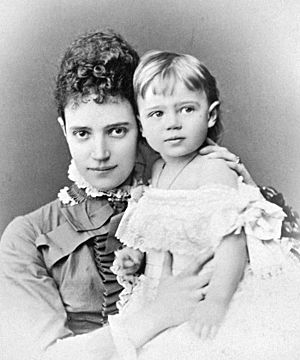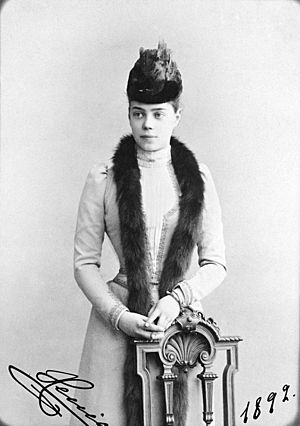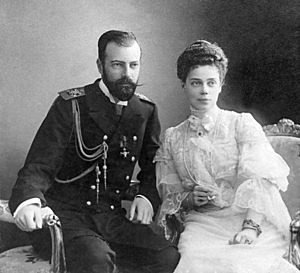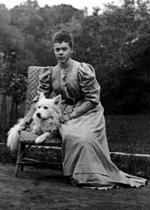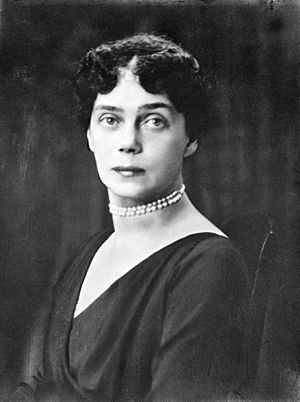Grand Duchess Xenia Alexandrovna of Russia facts for kids
Quick facts for kids Grand Duchess Xenia Alexandrovna of Russia |
|
|---|---|
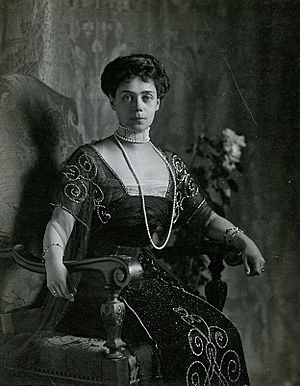
Grand Duchess Xenia, 1910s
|
|
| Born | 6 April 1875 Anichkov Palace, Saint Petersburg, Russian Empire |
| Died | 20 April 1960 (aged 85) Wilderness House, Hampton Court Palace, Richmond upon Thames, United Kingdom |
| Burial | Cimetière de Roquebrune-Cap-Martin, Roquebrune-Cap-Martin, France |
| Spouse |
Grand Duke Alexander Mikhailovich of Russia
(m. 1894; died 1933) |
| Issue |
|
| House | Holstein-Gottorp-Romanov |
| Father | Alexander III of Russia |
| Mother | Dagmar of Denmark |
Grand Duchess Xenia Alexandrovna of Russia (born April 6, 1875 – died April 20, 1960) was a Russian princess. She was the fourth child and older daughter of Emperor Alexander III and Empress Maria Feodorovna. Her brother was Emperor Nicholas II, the last ruler of Russia.
Xenia married her father's cousin, Grand Duke Alexander Mikhailovich of Russia. They had seven children together. She was also the mother-in-law of Felix Yusupov. He was involved in the death of Grigori Rasputin, a healer who helped her nephew, Tsarevich Alexei Nikolaevich of Russia. During her brother's rule, Xenia worried about how he was leading the country. After the Russian monarchy ended in 1917, she left Russia. She eventually made her home in the United Kingdom. Her great-grandson, Alexis Romanoff, has been a leader of the Romanov Family since 2021.
Contents
Growing Up in Russia
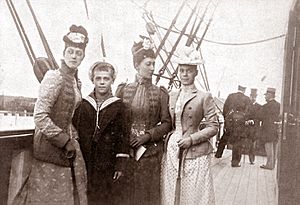
Grand Duchess Xenia Alexandrovna was born on April 6, 1875, in St. Petersburg. She was born at the Anichkov Palace. Her parents were Tsesarevich Alexander and Grand Duchess Maria Feodorovna. Xenia was one of their six children.
When Xenia was five, her grandfather, Emperor Alexander II, was killed. Her father then became Emperor Alexander III. Because of safety concerns, her family moved from the Winter Palace to Gatchina Palace.
At Gatchina, Xenia and her siblings had a simple childhood. They slept on cot beds and woke up early. Their rooms were plain but comfortable. Private tutors taught Xenia and her brothers. They focused on learning different languages. Xenia learned English, French, and German, besides her native Russian. She also learned cooking and making puppets. She enjoyed riding horses, fishing, drawing, and playing the piano.
Her family often spent holidays in Denmark. They visited her Danish grandparents at Fredensborg Castle. There, Xenia met her cousin and friend, Princess Marie of Greece. A Danish composer even wrote a song for Xenia.
Early Marriage and Family Life
Xenia grew up playing with her cousin, Grand Duke Alexander Mikhailovich of Russia. He was often called Sandro. They became close friends. When Xenia was 15, she and Alexander wanted to marry. However, her parents thought she was too young. They also had doubts about Alexander.
Finally, in January 1894, Xenia's parents agreed to the marriage. Xenia and Alexander were married on August 6, 1894. Xenia was 19 years old. The wedding took place at the Peterhof Palace. Xenia's younger sister, Olga, said their father was very happy that day.
They spent their honeymoon in Crimea. Soon after, Xenia's father, Emperor Alexander III, became ill. He died on November 1, 1894. After his death, Xenia's older brother, Nicholas, became the new Emperor Nicholas II.
Xenia and Alexander had seven children: one daughter and six sons. Their daughter, Princess Irina, married Prince Felix Yussupov. He was from a very wealthy family. Their wedding was held in February 1914. The Emperor Nicholas II gave Irina away.
Helping Others
Grand Duchess Xenia was very involved in charity work. She was part of the Women's Patriotic Association. From 1903, she supported the Creche Society of St. Petersburg. This group cared for children of poor working parents.
She also cared about hospitals for people with tuberculosis in the Crimea. This might have been because her brother George died from the disease in 1899. Xenia also supported the Maritime Naval Welfare Association. This group helped the families of naval workers. She started the Xenia Association to help children of workers and airmen. She was also a patron of the Kseniinsky Institute. This was a boarding school in St. Petersburg for 350 students.
Times of Trouble in Russia
On January 25, 1904, Xenia wrote in her diary that Russia and Japan had declared war. She had thought there would be no war. As the war began, there was unrest in Russia.
In January 1905, a large group of peaceful people went to the Winter Palace. They wanted to give a petition to the Emperor. The police and army fired into the crowd. Many people were hurt. This day became known as "Bloody Sunday." It changed the relationship between the Emperor and his people. Soon after, Xenia's uncle, Sergei, was killed by a bomb.
Xenia was upset when Russia lost the war with Japan. She wrote that the war "ended even more stupidly!" She was in Crimea when news came of a mutiny in the Black Sea fleet. In October, her brother, the Emperor, had to agree to create a Duma. This was a new elected assembly. Some in Xenia's family saw this as the end of the Emperor's absolute power.
World War I and the Revolution
When World War I started, Xenia was in France. Her mother was in London. They managed to travel back to Russia. Once home, Xenia helped with the war effort. She provided her own hospital train. She also opened a large hospital for wounded soldiers. She led the Xenia Institute, which made artificial limbs for injured people.
In 1915, Xenia tried to convince her brother, Nicholas, not to take command of the army. She went with her mother to talk to him. But Nicholas did not listen. Xenia felt very discouraged.
As Russia's situation worsened, Xenia became more worried. She and her family moved to their home in Crimea. There, she heard about the death of Grigori Rasputin. Her son-in-law was involved in this event. In early 1917, Xenia hoped her mother could help Nicholas understand the problems in Russia. But her mother felt she could not do anything.
On February 19, 1917, Xenia was back in St. Petersburg. On February 25, she wrote in her diary about disturbances in the city. People were asking for bread, and factories were on strike. On March 1, she heard rumors that Nicholas had been forced to give up his throne. Xenia tried to see her brother but was not allowed. Seeing no future in St. Petersburg, Xenia left for Crimea on April 6, her 42nd birthday.
Life in Exile
Xenia arrived in Crimea on March 28, 1917. She joined her mother, husband, and sister there. In 1918, Xenia learned that her brother Nicholas II, his wife, and their children had been killed by the Bolsheviks. Her last surviving brother, Michael, had also been killed a month earlier.
As the Red Army got closer to Crimea, Xenia and her mother escaped Russia. This was on April 11, 1919. King George V of the United Kingdom sent a British warship, the HMS Marlborough. It took them and sixteen other Romanovs from Crimea to England. Xenia stayed in Great Britain. Her mother later moved to Denmark.
Later Years in England
By 1925, Xenia was struggling financially. Her cousin, King George V, allowed her to live in Frogmore Cottage. This was a house on the royal estate in Windsor. She was very thankful for this help. Later, she had to deal with a woman named Anna Anderson. This woman claimed to be Xenia's niece, Grand Duchess Anastasia Nikolaevna of Russia. But Xenia and her family knew this was not true.
Xenia visited her mother in Denmark often. Her mother lived in a villa that she and her sister had bought. In 1928, Xenia's mother became very ill and passed away. After her mother's death, selling the villa and her jewels brought some money.
On February 26, 1933, Xenia's husband, Sandro, died. Xenia and her sons went to his funeral in France. By 1937, Xenia had moved to Wilderness House. This house was on the grounds of Hampton Court Palace. She lived there until she died on April 20, 1960. Even though she had less money in her later life, Xenia left a small amount to her family.
Family Relationships
Xenia was very close to her brother Nicholas II and his wife, Alexandra, before they married. After Nicholas and Alexandra married, Xenia and her husband often spent evenings with them.
However, a problem grew between Xenia and Alexandra. Xenia had six healthy sons. Alexandra had four daughters, and her only son, Alexei, had haemophilia. The good health of Xenia's sons bothered Alexandra. Xenia only learned about Alexei's haemophilia in 1912.
Because of Alexei's illness, Alexandra became very powerful over her husband. She sought help for her son, and this led her to trust Grigori Rasputin. Like the rest of her family, Xenia was very doubtful about Rasputin. This caused tension in the family. Still, Xenia remained close to her brother Nicholas. He often visited her in Crimea.
Xenia was also devoted to her other two brothers, Grand Duke George Alexandrovich of Russia and Grand Duke Michael Alexandrovich. George died from tuberculosis in 1899. Michael married without the Emperor's permission. This meant he was sent away from Russia. Xenia understood his situation because of her own marriage problems. She helped Michael and their mother become close again.
Records and Collections
Xenia Alexandrovna's personal papers are kept in the Hoover Institution Archives in California, USA. These papers include letters, diaries, and photos. Her letters with her brother, Emperor Nicholas II, and her mother, Empress Marie Feodorovna, are especially interesting.
Xenia and her staff also kept detailed, hand-written records of her jewelry and art. These records survived her exile.
Images for kids
See also
 In Spanish: Xenia Románova para niños
In Spanish: Xenia Románova para niños


